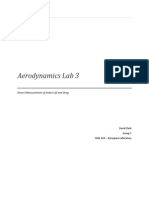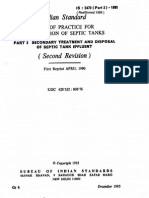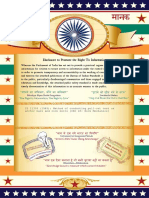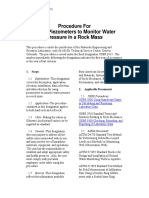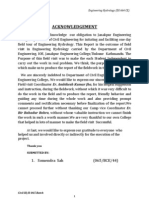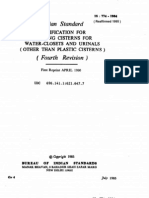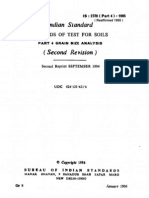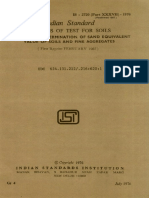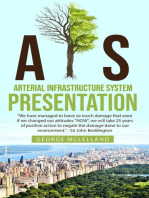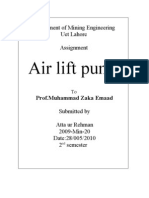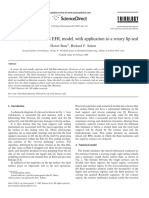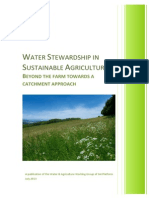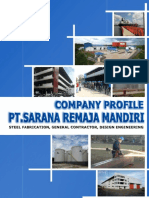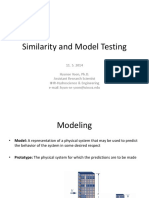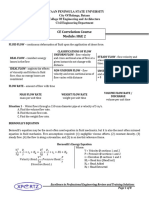Is 6935 1973
Is 6935 1973
Uploaded by
Rajashekar.PCopyright:
Available Formats
Is 6935 1973
Is 6935 1973
Uploaded by
Rajashekar.POriginal Title
Copyright
Available Formats
Share this document
Did you find this document useful?
Is this content inappropriate?
Copyright:
Available Formats
Is 6935 1973
Is 6935 1973
Uploaded by
Rajashekar.PCopyright:
Available Formats
Disclosure to Promote the Right To Information
Whereas the Parliament of India has set out to provide a practical regime of right to
information for citizens to secure access to information under the control of public authorities,
in order to promote transparency and accountability in the working of every public authority,
and whereas the attached publication of the Bureau of Indian Standards is of particular interest
to the public, particularly disadvantaged communities and those engaged in the pursuit of
education and knowledge, the attached public safety standard is made available to promote the
timely dissemination of this information in an accurate manner to the public.
!"#$%&# '(%)
!"# $ %& #' (")* &" +#,-.
Satyanarayan Gangaram Pitroda
Invent a New India Using Knowledge
/0)"1 &2 324 #' 5 *)6
Jawaharlal Nehru
Step Out From the Old to the New
7"#1 &" 8+9&"), 7:1 &" 8+9&")
Mazdoor Kisan Shakti Sangathan
The Right to Information, The Right to Live
!"# %& ;<" =7"#" > 72 &(: ?0)"@" #AB 7" <&*" A*
Bhart+hariN,ti-atakam
Knowledge is such a treasure which cannot be stolen
IS 6935 (1973): Method for determination of water level in
a bore hole [WRD 5: Gelogical Investigation and Subsurface
Exploration]
IS : 6935 - 1973
I ndian Standard
( Rcm5rmed 1989 )
METHOD FOR GETERMINATION 0~
WATER LEVEL IN A BOREHOLE
( Third Reprint APRIL 1990 )
UDC 628.112.24:681.128
I
Q copyright 1973
I:
i
BUREAU OF INDIAN STANDARDS
MANAK BHAVAN, 9 BAHADUR SHAH ZAFAR MARG
1
NEW DELHI 110002
I
Gr 3
September 1973
( Reaffirmed 2012 )
IS I 6935 - 1973
h&an Standard
METHOD ,FOR DETERMINATION OF
WATER LEVEL IN A BOREHOLE
Subsurface Exploration Sekional Committee, BDC 49
-
R@ruenting
snm v. s. icma%NmAw Ccologidal Survey of India, Lucknow
Chmw %OlNBFiR Natis: P&cts Construction Corporation Ltd,
S~nr S. K. AOO~RWAL ( Alkmatr )
CHI EF & haRR ( IRRIOATION ) Irrigation & Power Department, Government of
Rajasthan
SHIU K. N. D&DIN* In personaI capacity (P-920, Bidck P, Nsw A&ore,
calnrfta )
SHEIK. R. DATY~ . In personal capacity ( No. 2, Rehem Mansion, First
Floor, Cofaba Causeway, Bombay f 00001
SHRI R. c. DESAI
Rodio Foundation Engineering Ltd; and k azarat &
!j HRI v. R. h+usR!~R
Cc+ Bombay
Irrigation & Power Department, Government of
Mabarasbtra
SHRI S. M..BHAL~RAO ( AI &nab )
DI-R ( CSMRS ) Ckntral Water & Power Commission, New Delhi
SUPERINTENDINO ENQINIIBR,
C H B x4 A B INVSSTIOA~~N
GIROLB ( Alternate)
SHRI H. Dot+!
&RI V. L. GORIANI ( Alkrnafe )
Christensen-Longyear( India ) Ltd, Bombay
sHR1s.N.K. hEN&%R Cementation Co Ltd, Bombay
SHRI 0. S. .1151N
Central Building Research Institute ( CSIR ),
Roorkee
SHRI DIWENDRA SHARMA ( Albrna~ )
SHRI V. K. KIRPALANI
Volta, Limited, Bombay
siRI A.N.INDuRRAR (Alwk)
SHRI J. F. Mtsmy
SHRI H. C. PARMAR ( Alfemute )
Public Works Department, Government of Gujarat
SHRI K. S. S. MURTHY
Ministry of Irrigation & Power, New Delhi
SHRI B. K. PANTHAKY
sHRIM.s.~AN(Aht&)
Hindustan Construction Co Ltd, Bombay
SHRI C. GOP+MWAYY RAO
Public Works & Electrical Department, Government
of Mysore
RHPRESENTATIVE
Engineering Research Laboratories, Hyderabad
( Continued on&fc 2 )
Q Copyright 1973
BUREAU OF INDIAN STANDARDS
This publication is protected under the Indirrn Copyright Act ( XIV of 1957) and
reproduction in whole or in part by any veans exapt with written permission of the
publisher shall be deemed to be an infringement of copyright under the said Act.
1s t 6935 - 1973
( Continuedfram page 1)
Msmbsrs Refiescnting
REPREsENTAn%% Government of Himachal Pradesh
SBRI R. K. SABHARWAL
&RI s. s. SAHI
Larsen and Toubro L&l, New Delhi
SWRI M. M. ANAND ( Alternate)
Public Works Drpartment, Government of Punjab
SHRI S. SATAPATXII Irrig$atta & Power Department, Government of
SECRETARY
SARI H. D. SHARMA
Central Board of Irrigation & Power, New Delhi
SHRI P. S. YOO
Irrigation Research Institute, Roorkee
SHRI D. AJITHA SIMHA,
Irrigation Department, Government of Uttar Pradesh
Director ( Civ Engg )
Dirrctor General, IS1 ( Ex-o&o Membn )
Surelary
SHRI G. RAMAN
Deputy Director ( Civ Engg ), IS1 .
Ground Water and Field Permeability Test Panel, BDC 49 : P3
Convener
I
SHRI V. S. KRISHNASWAMY Geological Survey of India, Lucknow
Members
DIRECTOR Irrigation Research Institute, Poondi ( Tamil Nadu )
ASSISTANT RESEARIX OPP_ICER ( Ahrnate )
SHRI M. S.~JAIN
SHRI B. N. HIJKKU ( Alternate )
Geological Survey of India, Lucknow
SRRI S. K. SHOME ( Alternate )
I~BPRESENT.~~VE
RESEARCH OFFICER
Enginrering Research Laborltories, Hyderabad
Irrigation Research Institute, Roorkee
2
IS : 6935 - 1973
I ndian Standard
METHOD FOR DETERMINATION OF
WATER LEVEL IN A BOREHOLE
0. FOREWORD
0.1 This Indian Standard was adopted by the Indian Standards Institution
on 2 April 1973, after the draft finalized by the Subsurface Exploration
Sectional Comnuttee had been approved by the Civil Engineering Division
Council.
0.2 The location of ground water level is an important parameter in the
design of foundations of structures. Hence its correct determination is an
important part of subsurface exploration.
0.3 In the formulation of this standard due weightage has been given to
international co-ordination among the standards and practices prevailing
in different countries in addition to relating it to the practices in the field
in this country.
0.4 In reporting the result of-a test or analysis made in accordance with
this standard, if the final value, observed or calculated, is to be rounded
off, it shall be done in accordance with IS : 2-1960*.
1. SCOPE
1.1 This standard lays down the procedure for the determination of the
water level in a borehole, cased or uncased, either during the boring operation
or within a short time of the completion of the boring operation. This
standard is also applicable to determining ofground water level in permanent
observation holes.
1.2 This standard is not applicable for the determination of piezometric
pressure changes due to a change in stress conditions of the soil or rock.
1.3 Borehole water level readings obtained by this procedure shall be
supported with additional data if the water level readings are to be used
to infer the elevation of the free ground water level in the vicinity of the
borehole.
The prdcedure for the determination of the ground water level
by-the application of the borehole water level is given in Appendix A.
*Rules for rounding off numerical valuer f nuisrd).
3
IS : ,6935 - 1973
1.4 This standard is not applicable for the concurrent determination of
multiple water levels in a borehole.
NOTE -Multiple water levels can only be determined sequentially as the borehole
progresses, with the upper aquifers completely sealed off from the borehole.
Concurrent
multiple water level readings can only be obtained by the insertion of an adequate
number of piezometers at appropriate levels or by the installation of multiple packers
isolating the different aquifers in a drill hole under the guidance of a qualified engineer
or geologist.
2. DEFINITIONS
2.0 For the purpose of this standard the following definitions shall apply.
2.1 Borehole Water Level - The water level as measured at any time in
a borehole.
2.2 Free Ground Water Level - The upper boundary of the saturated soil
or rock at the time of measurement in an unconfined aquifer.
2.3 Piezometric Pressure -The hydraulic pressure head at a given
point in the soil or rock mass in a confined aquifer.
2.4 Aquifer-A soil or rock formation that is capable of storing and
yielding ground water.
3. MEASURING APPARATUS SUITABLE FOR READING WATER
LEVELS
3.1 Measuring Apparatus - Measuring apparatus conforming to one
of the items given in 3.1.1 to 3.1.4 shall be used for reading borehole water
levels.
3.1.1 Taje With a Weight - A steel tape having graduation of 5 mm
shall be used. For ease of measurement the tape may be chalked for
a length of about one metre at the lower end. The weight shall have a
volume such that it displaces a volume of water in the borehole that will
not cause more than a lo-mm increase in the water level of the hole ( see
Note ) .
NOTE -Volumes of various sizes of holes for 10 mm depth of hole and the weight
of lead weights for this volume are given below:
Hole Sirs, Die Volume of IO mm
Depth oj Hole
Ltad Wright
mm
60
76
100
150
cm8
g
28
320
45
510
79
900
176
2000
4
IS : 6935 - 1973
3.1.2 Electrical Measuring Device -
Such a device as in Fig. 1 shall be
equipped with a tip or probe at the end of the cable or suspending cord and
the probe shall be streamlined and so designed that it shall not catch on
any edge and it shall complete the circuit only when it contacts the water.
The weight of the probe shall be enough to keep the cable straight, the cable
shall not get stretched in length under its own weight and the weight of the
probe, if the cable is directly used for measurement. The cable shall be
marked with graduations similar to those on an acceptable tape or the
cable/suspending cord shall be measured subsequent to withdrawal with
an acceptable tape to determine the elevation of the water level in the
borehole.
GALVANOMETER
u
NOTE
circuit.
- In case of dry ground either connect the negative to casing or use two-wire
FIG. 1 DIAGRAM ILLUSTRATING USE OF ELECTRICJAL EQUIPMENT FOR
MEASURING GROUND WATER LEVEL
3.1.3 Automatic Water hue1 Recorder - The recorder shall be calibrated
to read depth variations to the desired accuracy.
Nob - This ia used where a continuous record of the fluctuationr of water level over
a gpecified period of time has to be obtained.
3.1.4 A Bell Sounder - Consists of a solid brass rod about 78 mm long
and diameter to suit hole, ending in a inverted cup ( for typical illustration
ste Fig. 2 ). A steel measuring tape is attached to the upper end. The
length of the sounder below the zero of the tape shall be measured carefully
and added to each reading of the tape to get the true distance. The moment
the cup of the sounder hits the water surface within the pipe, a distinct
plop will be heard.
5
IS:6935-1973
+20---d 2mm @
A?- HOLE
SECTJON XX
All dimensions in millimetres.
FIG. 2 BELL SOUNDER
6
IS I 693s - 1973
4. PROCEDURE FOR OBTAINING BOREHOLE WATER LEVELS
4.1 Hole Made by Wet Drilling Method - When the hole has been made
by a wet drilling method ensure that the water level in the hole is the same
as ground water level by depressing the water level by evacuating with
compressed air or with a sand shell. After this operation is completed take 3
(more if required ) water level readings at 10 to 15 min intervals if the
last two consecutive readings do not differ by more than 5 cm, the
corresponding lower water level should be taken as the ground water level
( see Appendix A ) .
4.2 Dole Made Using Drilling Mud - When drilling mud has been used
thoroughly flush and wash the hole with clean water. Then determine the
ground water level as in 4.1 ( see Appendix A ).
4.3 Hole Made by Dry DrilRng Method - When the hole is bored by
dry drilling method, determine the ground water level as soon as it is inferred
that the ground water level has been reached, without advancing the hole
further. Take a series of 3 ( or more if required ) readings at approximately
equal intervals with a minimum of 5 min elapsed time between readings.
In an exceptionally previous strata the interval may be reduced to as low as
one minute ( see Appendix A ).
4.4 Other Requirements for All Water Level Determinations
4.4.1 Ensure that all sarface seepage water has been sealed off from flowing
into the borehole.
4.4.2 In case the subsoil strata in the vicinity of the water table in a bore-
hole consists of loose cohesionless material or other material which may lead
to caving of hole due to fluctuation of water level or due to flushing and
washing with clean water, case the hole beforehand in order to prevent the
water level in the hole being vitiated by possible collapse of the hole. In
case of permanent water level observation wells the casing shall be blank up
to ground water table and of perforated pipe below. If casing is used to seal
off seepage water or to prevent the hole from caving, then the hole shall be
extended below the casing 1 to-2 casing diameters, and preferably not more
than 10 to 15 cm.
4.4.3 Record the date, the time and the elevation of all the water level
readings taken.
4.4.4 Cap hole between readings ifreadings are to be taken over an exteod-
ed period of time.
5. DATA TO BE RECORDED
5.1 The following data shall be recorded for each series of borehole water
level reading taken:
a) Datum of reference point from which measurementi were t&en, .
and
7
IS r6935 -1973
b) Log of borehole ( see IS : 4464-1965* ),
5.2 When required the following data may also be recorded:
4
b)
4
4
4
Time that has elapsed since last change in the water level in the
borehole,
Depth of water columF above bottom of the borehole and the
length of casing in the borehole,
Atmospheric pressure at the time water level was taken,
Fluctuation in water ievels of nearby bodies of water which may
affect water level readings in the borehole and recording time and
magnitude of this fluctuation, and
Distance to closest adjacent borehole if the adjacent hole might
have some effect on the borehole water level.
APPENDIX A
( Chuses 1.3, 4.1, 4.2 and 4.3 )
DETERMINING THE GROUND WATER LEVEL BY THE
APPLICATIeN OF BOREHOLE WATER LEVEJ ,
A-l. APPLICABILITY OF BOREHOLE WATER LEVEL
A-l.1 Borehole water levels taken while water is being circulated to advance
the borehole will bear no relation to the ground water level unless sufficient
time is allowed for the borehole water level to stabilize near the ground
water level.
A-l .2 Boreholes drilled by dry methods may have advanced below the ground
water table before water is noticed in a borehole. A borehole water level
reading taken before the water level has had time to stabilize will not
correctly represent the ground water level.
A-l.3 In many areas more than one ground water level may be found due
to an itipervious material lying between two aquifers and effectively separat-
ing them.
A borehole penetrating the impervious layer then becomes
a channel for water to flow froin one aquifer to the other and the borehole
wat&r level will stabilize at some elevation between the ground water eleva-
tions in the two aquifers.
A-1.4 Drilling mud used in a borehole can effectively seal off pervious forma-
&ns preventing the fluid in the borehole to drop to the existing @ound water
level or vice versu.
/
*Code of practice for prwcntation of drilling information and core description in
foundation investigation.
8
IS : 6935 - 1973
A-l.5 The time required for a borehole water level to stabilize at or near
the ground water level depends upon the permeability of the formation and
the initial head differential between the borehole water level and the ground
water level. Typical times required for 90 percent of this initial gap between
the water levels to close when soil is flush with the bottom of the casing are
given below:
4
b)
cl
4
4
Medium and coarse sand 1 to 6 min
Fine sand &bout 1 h.
Medium and coarse & ( see Note 1 ) 4 to 4 days
Fine silt ( see Note 1 ) Up to 42 days
Clay ( see Note 1 ) Not practical to deter-
mine free ground water
level from boreholes un-
less material is fissured.
NOTE 1 - The above limits are meant as a guide. While dealing with these formatiobs
porous tube pirzometers will be found more, suitable for observation of ground water
level. For details of these piezometers r&rence may be made to the draft Indian
Standard code of practice for installation, maintenance and observation of instruments
in earth dams: Porous tube ( Casagrande type) piezometenl ( under ~rcp~mtion)
(zeeNote2).
NOTE 2
- Until this standard is published, the matter shall be subject to agreement
between the concerned parties.
A-1.5.1 If the hole is extended about 3 diameters below the bottom of the
casing, the increased intake area will reduce the time required to about 25
percent of the values given in A-1.5.
A-2. INTERPRETATION OF BOREHOLE WATER LEVEL
A-2.1 If free communication has been established w&h the formation, and
there is no seepage into the borehole Corn overlgng formations the stabilized
borehole water level will be closely equivalent to the ground water le&l in
the formation.
A-2.2 For artesian conditions where the formation is ov&la.in by an
impervious layer the stabilized borehole water level will be equivalent to
the pressure head in the formation.
A-2.3 If insufficient time is spent waiting for the borehole water level to
stabilize, the inferred position of the ground water level may be calculated
from the following equation if three boreholc water level readinga arc taken
at &able equal time intervals
IS : 6935 - 1973
where
h, = the distance the borehole water level silall change in order
to bc closely cquivalcnt to the ground water level,
h, = the distance the boreholc water level changed during the
time interval between the first two borehole water lcvei
readings, and
h, = the distance the borcholc water level changed during the
time interval between the xcond and the third borehole
water level readings.
P\OTE - The formula in A-2.3 is based OIL the theory of hydrostatic time lag.
-
BUREAU OF I NDI AN STANDARDS
Headquarters:
Manak Bhavan, 9 Bahadur Shah Zafar Marg, NEW DELHI 110002
Telephones: 331 01 31, 331 13 75 Telegrams: Manaksanstha
( Common to all Offices )
Regional Offices: Telephone
Central Manak Bhavan, 9 Bahadur Shah Zafar Marg.
I
331 01 31
NEW DELHI 110002 331 1375
*Eastern : l/l 4 C. I. T. Scheme VII M, V. I. P. Road,
36 24 99
Maniktola, CALCUTTA 700054
Northern : SC0 445-446, Sector 35-C,
I
21843
CHANDIGARH 160036 3 16 41
1
41 24 42
Southern : C. I. T. Campus, MADRAS 600113
:: 22: :s9
tWestern : Manakalaya, E9 MIDC, Marol, Andheri ( East ), 6 32 95 95
BOMBAY 400093
Branch Offices:
Pushpak. Nurmohamed Shaikh Marg, Khanpur,
I
2 63 48
AHMADABAD 380001
2 63 49
SPeenya Industrial Area 1 sr Stage, Bangalore Tumkur Road 38 49 55
BANGALORE 560058
Gangotri Complex, 5th Floor, Bhadbhada Road, T. T. Nagar,
i
38 49 56
667 16
BHOPAL 462003
Plot No. 82183. Lewis Road. BHUBANESHWAR 751002
53j5. Ward No. 29, R.G. Barua Road, 5th Byelane,
GUWAHATI 781003
5 36 27
3 31 77
5-8-56C L. N. Gupta Marg ( Nampally Station Road ),
HYDERABAD 500001
23 1083
R14 Yudhister Marg. C Scheme, JAlPUR 302005
(
634 71
6 98 32
117/418 B Sarvodaya Nagar, KANPUR 2O8005
{
;; 6s: 3;
Patliputra Industrial Estate, PATNA 800013 6 23 05
T.C. No. 14/l 421. University P.O.. Palayam (6 21 04
TRIVANDRUM 695035 16 21 17
/nspection Offices ( With Sale Point ):
Pushpanjali. First Floor, 205-A West High Court Road, 2 51 71
Shankar Nagar Square, NAGPUR 440010
Institution of Engineers ( India ) Building, 1332 Shivaji Nagar, 5 24 35
PUNE 411005
*Sales Office in Calcutta is at 5 Chowringhee P. 0. 27 69 00
Street. Calcutta 700072
Approach, Princep
tSales Office in Bombay is at Novelty Chambers, Grant Road, 89 66 26
Bombay 400007
$Sales Office in Bangalore is at Unity Building, Narasimharaja Square, 22 35 71
Bangalore 560002
Reprography Unit, BIS, New Delhi, India
You might also like
- Aerodynamics Lab 3 - Direct Measurements of Airfoil Lift and DragDocument18 pagesAerodynamics Lab 3 - Direct Measurements of Airfoil Lift and DragDavid Clark83% (12)
- Pe03023 QaDocument25 pagesPe03023 QaFariz Adriansyah100% (1)
- Is 2720.8.1983Document14 pagesIs 2720.8.1983Elumalai Srinivasan100% (2)
- Is 1192 1981 PDFDocument57 pagesIs 1192 1981 PDFoctatheweelNo ratings yet
- Disclosure To Promote The Right To InformationDocument26 pagesDisclosure To Promote The Right To InformationHabib Ur Rahman100% (1)
- Is 7114 1973Document15 pagesIs 7114 1973praveena61No ratings yet
- Is 11485.1985 PDFDocument18 pagesIs 11485.1985 PDFHiren PatelNo ratings yet
- Disclosure To Promote The Right To InformationDocument15 pagesDisclosure To Promote The Right To InformationKishore DamarasettiNo ratings yet
- 2720 8Document11 pages2720 8Himanku BoraNo ratings yet
- IS 2720 Part-41.1977Document20 pagesIS 2720 Part-41.1977कृत्या नंद झाNo ratings yet
- Is 11223 1985Document16 pagesIs 11223 1985SumaiyakhanamNo ratings yet
- 08 - Bottom Stability AnalysisDocument7 pages08 - Bottom Stability AnalysisDang Dinh ChiNo ratings yet
- Is 6966 1 1989 PDFDocument19 pagesIs 6966 1 1989 PDFPrachita RautNo ratings yet
- Is.6966.1.1989. Hydraulic Design Indian StandardDocument19 pagesIs.6966.1.1989. Hydraulic Design Indian StandarderamitdhanukaNo ratings yet
- IS 12175 - 1987 For Rapid Moisture Meter PDFDocument14 pagesIS 12175 - 1987 For Rapid Moisture Meter PDFDakshina MurthyNo ratings yet
- Vashi Creek Water Quality NaviMumbaiDocument27 pagesVashi Creek Water Quality NaviMumbairanucNo ratings yet
- Barrage DesignDocument30 pagesBarrage DesignFaisal Junaid0% (1)
- Is-2470 - 2 Septic TankDocument24 pagesIs-2470 - 2 Septic TankRam Balak Roy0% (1)
- Is 5313 1980Document14 pagesIs 5313 1980rajenkoleyNo ratings yet
- Hydrographic SurveyingDocument6 pagesHydrographic SurveyingNikhil ManeNo ratings yet
- Is 2720 2 1973 PDFDocument24 pagesIs 2720 2 1973 PDFbiswanirman100% (1)
- Is 7357 1974Document17 pagesIs 7357 1974Bhaskar ReddyNo ratings yet
- Is.2131.1981 SPTDocument15 pagesIs.2131.1981 SPTrajeshji_000100% (1)
- 2720 (Part-XXI) PDFDocument10 pages2720 (Part-XXI) PDFSoundar PachiappanNo ratings yet
- (Second Revision) : Indian Standard /L - QPNJ /?WDocument11 pages(Second Revision) : Indian Standard /L - QPNJ /?Wvkg2007No ratings yet
- 4967 PDFDocument12 pages4967 PDFakhilashNo ratings yet
- Is 2470 - 2Document24 pagesIs 2470 - 2lunar_vipNo ratings yet
- Is.2470.1.1985 Septic Tank Part 2Document29 pagesIs.2470.1.1985 Septic Tank Part 2V Jay KrNo ratings yet
- Disclosure To Promote The Right To InformationDocument12 pagesDisclosure To Promote The Right To InformationRachel IngramNo ratings yet
- Disclosure To Promote The Right To InformationDocument20 pagesDisclosure To Promote The Right To InformationgayalamNo ratings yet
- Is 2373 Water MetersDocument25 pagesIs 2373 Water Metersnp27031990No ratings yet
- Indian Standard: Methods of Test For SoilsDocument10 pagesIndian Standard: Methods of Test For SoilsankitraginiNo ratings yet
- WTP - CFL - Indian Standard - Water Treatment PlantDocument18 pagesWTP - CFL - Indian Standard - Water Treatment Plantnimm1962100% (1)
- Disclosure To Promote The Right To InformationDocument25 pagesDisclosure To Promote The Right To Informationuserabcd9768100% (2)
- IS 4880-3 (1976) - Code of Practice For Design of Tunnels Conveying Water, Part 3 - Hydraulic Design PDFDocument20 pagesIS 4880-3 (1976) - Code of Practice For Design of Tunnels Conveying Water, Part 3 - Hydraulic Design PDFrahuldevpatel5No ratings yet
- Soil ReportDocument9 pagesSoil ReportHabib Ur RahmanNo ratings yet
- Is aNCHOR BOLT PULLOUT TEST PDFDocument10 pagesIs aNCHOR BOLT PULLOUT TEST PDFHiren JoshiNo ratings yet
- Procedure For Using Piezometers in A Rock MassDocument14 pagesProcedure For Using Piezometers in A Rock MassGiancarlo MarcariNo ratings yet
- Is 1122Document10 pagesIs 1122MiteshNo ratings yet
- Is 5529 2 2006Document19 pagesIs 5529 2 2006jayant mukherjee100% (1)
- Somendra Sah Hydrology Report PDFDocument18 pagesSomendra Sah Hydrology Report PDFSomendra ShahNo ratings yet
- Is 774 1984 R 1995Document24 pagesIs 774 1984 R 1995nagaraju3135No ratings yet
- IS 2720 Part 4Document15 pagesIS 2720 Part 4bhustlero0oNo ratings yet
- Is 8237 1985Document18 pagesIs 8237 1985Rajesh Joshi100% (1)
- Disclosure To Promote The Right To InformationDocument24 pagesDisclosure To Promote The Right To InformationRajashekar.PNo ratings yet
- Is 2720 Part-4 Methods of Test For Soils Grain Size Analy.182155414Document40 pagesIs 2720 Part-4 Methods of Test For Soils Grain Size Analy.182155414krityanand19900% (2)
- Velocity MethodDocument5 pagesVelocity MethodImr RaNo ratings yet
- Is.2951.2.1965 Head Loss in Flow Through PipesDocument19 pagesIs.2951.2.1965 Head Loss in Flow Through PipeskdpgrahiNo ratings yet
- 2720 37 PDFDocument18 pages2720 37 PDFSrinivas VogguNo ratings yet
- Plate Load Test Is.1888.1982Document16 pagesPlate Load Test Is.1888.1982cmthebossNo ratings yet
- Groundwater Technology Handbook: A Field Guide to Extraction and Usage of GroundwaterFrom EverandGroundwater Technology Handbook: A Field Guide to Extraction and Usage of GroundwaterRating: 5 out of 5 stars5/5 (1)
- Water Remote Sensing: Advancements in Computer Vision Techniques for Water Remote SensingFrom EverandWater Remote Sensing: Advancements in Computer Vision Techniques for Water Remote SensingNo ratings yet
- Physical and Chemical Techniques for Discharge Studies - Part 1From EverandPhysical and Chemical Techniques for Discharge Studies - Part 1RB SalamaNo ratings yet
- Systematic Methods of Water Quality Parameters Analysis: Analytical MethodsFrom EverandSystematic Methods of Water Quality Parameters Analysis: Analytical MethodsRating: 1 out of 5 stars1/5 (1)
- Fluid Dynamics in Complex Fractured-Porous SystemsFrom EverandFluid Dynamics in Complex Fractured-Porous SystemsBoris FaybishenkoNo ratings yet
- Instruments, Measurement Principles and Communication Technologies for Downhole Drilling EnvironmentsFrom EverandInstruments, Measurement Principles and Communication Technologies for Downhole Drilling EnvironmentsNo ratings yet
- Ijggi-July 2014Document46 pagesIjggi-July 2014Rajashekar.PNo ratings yet
- Das B M Soil Mechanics Laboratory ManualDocument165 pagesDas B M Soil Mechanics Laboratory ManualRajashekar.PNo ratings yet
- Rethalia PDFDocument17 pagesRethalia PDFRajashekar.PNo ratings yet
- Disclosure To Promote The Right To InformationDocument24 pagesDisclosure To Promote The Right To InformationRajashekar.PNo ratings yet
- Disclosure To Promote The Right To InformationDocument22 pagesDisclosure To Promote The Right To InformationRajashekar.PNo ratings yet
- IScodes Soil DynamicsDocument128 pagesIScodes Soil DynamicsRajashekar.PNo ratings yet
- Disclosure To Promote The Right To InformationDocument12 pagesDisclosure To Promote The Right To InformationRajashekar.PNo ratings yet
- Hot-Dip Zinc Coating On Structural Steel Bars For Concrete Reinforcement - SpecificationDocument7 pagesHot-Dip Zinc Coating On Structural Steel Bars For Concrete Reinforcement - SpecificationRajashekar.PNo ratings yet
- Celerity of Exposed Steel Pipes:-: (A) For A Pipe Anchored at The Upper End and Without Expansion JointsDocument5 pagesCelerity of Exposed Steel Pipes:-: (A) For A Pipe Anchored at The Upper End and Without Expansion JointsRajashekar.PNo ratings yet
- Indian Standard: Code of Practice For Use of Screed Board Concrete VibratorsDocument10 pagesIndian Standard: Code of Practice For Use of Screed Board Concrete VibratorsRajashekar.PNo ratings yet
- Indian Standard: Specification For Apparatus For Flexural Testing of ConcreteDocument10 pagesIndian Standard: Specification For Apparatus For Flexural Testing of ConcreteRajashekar.PNo ratings yet
- Whatisadam?: A Dam Is Any Structure Built Across A Stream, River, or Estuary To Retain WaterDocument24 pagesWhatisadam?: A Dam Is Any Structure Built Across A Stream, River, or Estuary To Retain WaterRajashekar.PNo ratings yet
- 12837Document7 pages12837massera.p2540No ratings yet
- EIL Civil SpecDocument341 pagesEIL Civil SpecRajashekar.P100% (3)
- Indian Standard: Specification For Concrete Transit Mixers and Agitators (ThirdDocument13 pagesIndian Standard: Specification For Concrete Transit Mixers and Agitators (ThirdRajashekar.PNo ratings yet
- Reaffirmed 1995Document14 pagesReaffirmed 1995Rajashekar.PNo ratings yet
- Reaffirmed 1997Document26 pagesReaffirmed 1997Rajashekar.PNo ratings yet
- Criteriafordesign Genlikator Foundation For Hydroelectric PowerstationsDocument10 pagesCriteriafordesign Genlikator Foundation For Hydroelectric PowerstationsRajashekar.PNo ratings yet
- Is 731 1971Document41 pagesIs 731 1971Rajashekar.PNo ratings yet
- Design Calculation Sheet: 1 of 1 Bulk Fuel Oil TanksDocument5 pagesDesign Calculation Sheet: 1 of 1 Bulk Fuel Oil TanksIslam SolimanNo ratings yet
- 5 - Boundary Layer 2013Document63 pages5 - Boundary Layer 2013mikeclarke1500No ratings yet
- Panel Operator-Govind Narayan KiradooDocument4 pagesPanel Operator-Govind Narayan KiradooDodiya NikunjNo ratings yet
- Air Lift PumpDocument4 pagesAir Lift PumpFoxty50% (4)
- BFP Data SheetDocument3 pagesBFP Data Sheetwael zakaria100% (1)
- Problem Solving Through SimilitudeDocument12 pagesProblem Solving Through SimilitudeNirmal LankaNo ratings yet
- Ansys Exercise 1Document4 pagesAnsys Exercise 1Subarna RegmiNo ratings yet
- Fiscal Metering ExercisesDocument22 pagesFiscal Metering ExercisesCassandra FreyaNo ratings yet
- Sheet No. 2-Vicous FlowDocument2 pagesSheet No. 2-Vicous Flowمحمد خريبطNo ratings yet
- An Unsteady Mixed Soft EHL Model, With Application To A Rotary Lip SealDocument6 pagesAn Unsteady Mixed Soft EHL Model, With Application To A Rotary Lip SealAhmed GalalNo ratings yet
- Packaged Drinking Water-Project ProfileDocument11 pagesPackaged Drinking Water-Project ProfileAshish KumarNo ratings yet
- CH 12 FrictionDocument6 pagesCH 12 Frictionlegendry gamingNo ratings yet
- An Explicit Equation For Friction Factor in PipeDocument2 pagesAn Explicit Equation For Friction Factor in PipeRiddhesh PatelNo ratings yet
- Wyckoff 2.0 Ruben VillahermonsaDocument60 pagesWyckoff 2.0 Ruben VillahermonsaDinesh CNo ratings yet
- Lift Pump CalculationDocument15 pagesLift Pump CalculationamrNo ratings yet
- ME Con-3Document8 pagesME Con-3vidya chakitwarNo ratings yet
- 1-0107-4-EN Grease Pump UnitsDocument8 pages1-0107-4-EN Grease Pump Unitsli geneNo ratings yet
- Product-Data-Sheet-Catalog-12 - (Two Phase Control Valve Sizing Calculation Fisher)Document41 pagesProduct-Data-Sheet-Catalog-12 - (Two Phase Control Valve Sizing Calculation Fisher)reninbabaski100% (1)
- Water Stewardship ReportDocument34 pagesWater Stewardship Reportpavan6754No ratings yet
- CalculatorsDocument11 pagesCalculatorsImran RasheedNo ratings yet
- Brosur Tanki SRMDocument30 pagesBrosur Tanki SRMSuci YatiningtiyasNo ratings yet
- Similarity and Model TestingDocument33 pagesSimilarity and Model TestingR. DeshmukhNo ratings yet
- ME 372 (Chapter-6) - Introduction To Convection Heat TransferDocument32 pagesME 372 (Chapter-6) - Introduction To Convection Heat Transferالياس يونس مرغلانيNo ratings yet
- Bernoulli's Equation FullDocument9 pagesBernoulli's Equation FullHaikal HarithNo ratings yet
- Skim Tank InternalsDocument2 pagesSkim Tank Internalsnatarajan Ravisankar100% (2)
- Coil Heat ExchangerDocument4 pagesCoil Heat ExchangerLalit ChaudhariNo ratings yet
- Pneumatic and Hydraulic For 5th YearDocument79 pagesPneumatic and Hydraulic For 5th Yearhuniegetu06No ratings yet
- BPSU - Module # 3 - HGE 2Document8 pagesBPSU - Module # 3 - HGE 2Mary Joy FideldiaNo ratings yet
